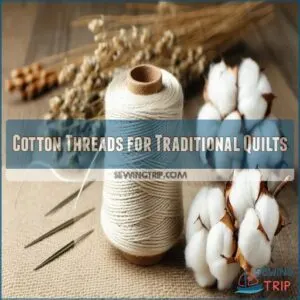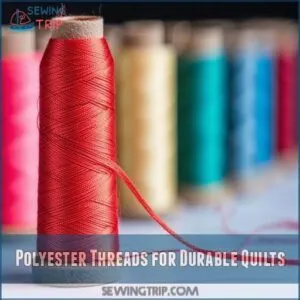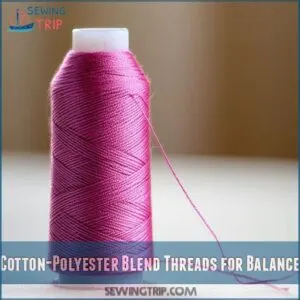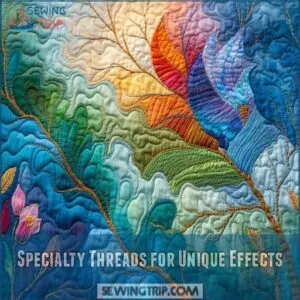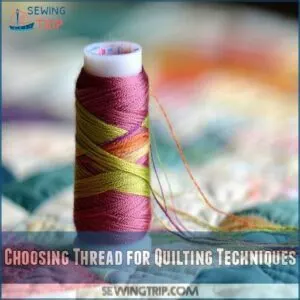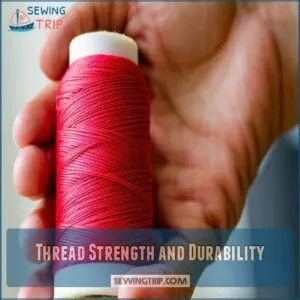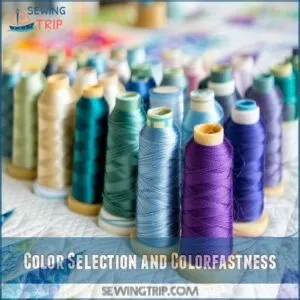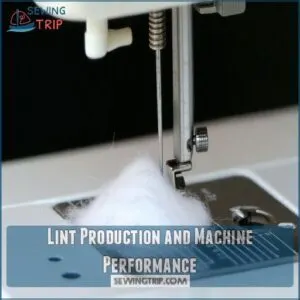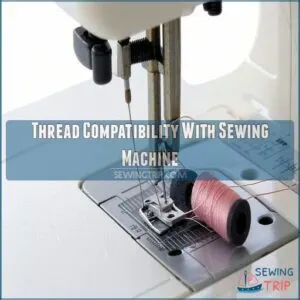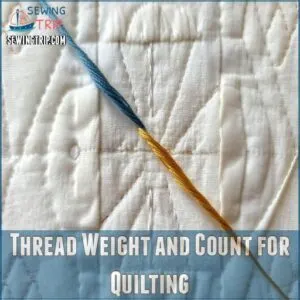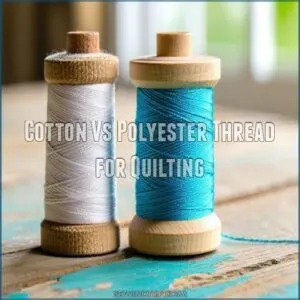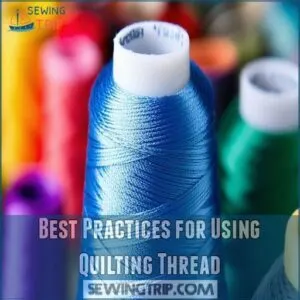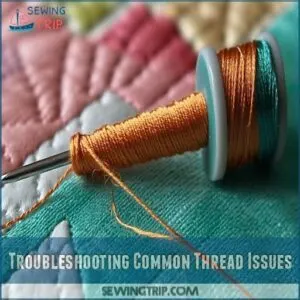This site is supported by our readers. We may earn a commission, at no cost to you, if you purchase through links.
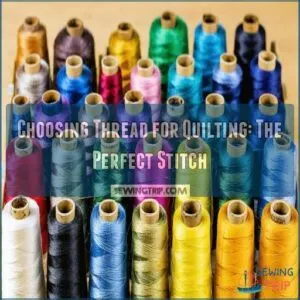
You’ll want to match thread content to fabric, like cotton thread for natural fibers or polyester for synthetics.
Think of thread type as your quilt’s personality: cotton for classic charm, polyester for tough durability, or a colorful variegated thread to make it pop.
Remember, test your thread choice on a fabric swatch before diving into the full quilt.
Want your stitches to blend or make a statement? That’s your call!
And there’s more to explore on achieving the perfect stitch…
Table Of Contents
- Key Takeaways
- Thread Types for Quilting
- Choosing Thread for Quilting Techniques
- Factors to Consider in Thread Selection
- Thread Weight and Count for Quilting
- Cotton Vs Polyester Thread for Quilting
- Best Practices for Using Quilting Thread
- Troubleshooting Common Thread Issues
- Frequently Asked Questions (FAQs)
- Conclusion
Key Takeaways
- Match your thread type to the fabric and project needs. Use cotton for classic quilts and softer applications, and choose polyester for strength and durability in high-use quilts.
- Always test your thread on a fabric swatch to ensure it complements the quilt’s design and doesn’t cause tension issues or breakages.
- Consider thread weight carefully: lighter threads offer intricate detail, while heavier ones provide added texture and durability.
- Store your threads properly, keeping them in a cool, dry place, and use suitable needle sizes to prevent breakage and enhance machine performance.
Thread Types for Quilting
When you’re choosing the perfect thread for quilting, it can feel like picking a favorite among candy flavors—each has its charm!
Specialty threads add a splash of magic.
Cotton offers a soft embrace.
Polyester provides robust durability.
There’s a thread type that’s just right for every quilting dream.
Cotton Threads for Traditional Quilts
When you’re diving into traditional quilts, cotton threads are your trusty sidekick.
Known for their gentle feel and natural finish, they’re perfect for heirloom pieces.
You can find a variety of cotton threads at online stores that sell the best cotton thread for quilting.
Brands like Aurifil and Gutermann offer vintage cotton threads with excellent thread strength.
Keep an eye on thread weight—it’s key for the perfect stitch.
Cotton threads, a beginner’s delight, bring tradition to your quilting journey.
Polyester Threads for Durable Quilts
Switching gears from the soft tones of cotton, polyester thread stands out as the muscle for your quilts.
Known for its remarkable strength and durability, it doesn’t bat an eyelid at frequent washing cycles.
When sewing polyester by hand or machine, its low lint production keeps your sewing machine happy, and it dances smoothly through the fabric with proper needle compatibility, making quilting a breeze.
Cotton-Polyester Blend Threads for Balance
Balancing strength and softness, the cotton-polyester blend thread gives you the best of both worlds when quilting. No more tug-of-war between durability and feel—this blend is your trusty companion.
- Versatility: Tackles various quilting projects.
- Cost-effective: A smart choice for budget-savvy quilters.
- Ease of use: Perfect for beginners.
- Reduced lint: Keeps your machine happy.
Specialty Threads for Unique Effects
Imagine adding a splash of fireworks to your quilt with specialty threads.
Metallic threads shimmer brilliantly, while variegated threads weave surprising colors, sparking visual interest.
Silk threads glide smoothly, offering a luxurious finish, and glow-in-the-dark threads add magical nighttime effects.
Always test these threads, adapting machine settings, ensuring creative freedom without frustration.
Specialty threads transform ordinary quilts into dazzling masterpieces.
Choosing Thread for Quilting Techniques
Choosing the right thread for your quilting techniques can feel like picking a needle from a haystack, but it doesn’t have to be overwhelming.
Each technique calls for a specific type of thread to bring your project to life.
Whether you’re piecing, machine quilting, hand stitching, or adding appliqué, each technique calls for a specific type of thread to bring your project to life.
Thread for Piecing Quilt Blocks
So, you’ve picked your quilting thread type—fantastic! Now, let’s talk piecing.
For those neat seams, you want a thin, strong thread. Think of it as the glue holding your quilt together.
When mastering sewing machine threading, remember to guide the thread correctly through the machine’s upper thread path to avoid tangles.
Here’s what to remember:
- Choose a thread weight that won’t bulk up your seams.
- Cotton thread works great for a soft feel.
- Matching your thread color to your fabric is key for invisible seams.
Thread for Machine Quilting
For machine quilting, the right thread transforms your project.
Choosing wisely avoids thread breakage and guarantees smooth stitches.
Opt for durable polyester for strength, or try cotton for a classic finish.
You can find a variety of machine quilting threads online at machine quilting thread stores.
Balance thread sheen with fabric texture.
Keep an eye on thread tension and bobbin winding for flawless results.
| Thread Type | Features | Best Use |
|---|---|---|
| Polyester | Strong | High-use quilts |
| Cotton | Soft feel | Traditional look |
| Silk | Luxurious | Decorative |
| Metallic | Shiny | Accent stitching |
| Variegated | Multi-color | Artistic flair |
Thread for Hand Quilting
When mastering hand quilting, you’ll want the right thread—it’s like finding the perfect partner for a dance.
Waxed thread glides smoothly through fabric, reducing knotting.
Choosing colors wisely complements your quilt’s design.
Hand quilting stitches shine when paired with hand quilting needles.
Keep thread tension balanced to avoid puckering.
Try different quilting thread types for the best results.
Thread for Appliqué Work
After hand quilting, appliqué opens up a world of creativity. Picking the right thread transforms your design. Consider these:
- Appliqué thread types: Choose cotton for blending or polyester for sheen.
- Thread weight: Opt for lightweight to keep your appliqué smooth.
- Thread color: Match or contrast?
- Invisible appliqué: Monofilament is nearly magic!
- Thread tension: Keep stitches even, tensions happy.
Factors to Consider in Thread Selection
When picking thread for quilting, you’ve got to think about strength and durability to keep your masterpiece intact, like making sure your toddler’s pants can survive a trip to the playground.
Choose colors that complement your design and guarantee they won’t fade faster than your enthusiasm at a Monday morning meeting.
Thread Strength and Durability
You know quilting’s secrets lie in thread strength and durability.
If your quilt faces rough use, go for thicker thread—it’s like calling in the cavalry.
High-twist threads resist knots and breakage, making them your trusty sidekick.
Here’s a look:
| Factor | Silk Thread | Cotton Thread | Polyester Thread |
|---|---|---|---|
| Strength | Medium | Good | Excellent |
| Durability | High | Moderate | High |
| Knot Resistance | Low | Medium | High |
| Lint Production | Low | High | Low |
Color Selection and Colorfastness
Choosing the right thread color can feel like picking a favorite crayon—it’s challenging!
Think color theory for quilting: match or contrast?
Consider colorfastness too, avoiding thread fading calamities.
Quilting thread brands vary in their dye lots, so test wash threads before stitching a masterpiece.
Smart color matching makes sure your quilt looks vibrant for years.
Remember, reliable thread brands save headaches!
Lint Production and Machine Performance
Let’s talk lint! Some threads are way more likely to leave a fuzzy mess in your machine than others.
Polyester threads, for example, are often touted as lint-free threads, making your machine quilting experience smoother.
Cotton threads? Not so much. Lint production directly impacts your machine’s performance; too much lint, and you’re dealing with thread breakage and frustrating jams.
Paying attention to lint production is key for maintaining your sewing machine and creating beautiful quilts! Think of it as a little preventative maintenance.
Thread Compatibility With Sewing Machine
Looking for the perfect stitch? It’s all about threading the needle just right.
Make sure your quilting thread, needle size, and bobbin type play well together.
If your machine’s sounding like an old jalopy, it might need a tune-up.
Don’t forget thread tension and thread guide compatibility.
With the right setup, your quilting machine will hum along beautifully.
Thread Weight and Count for Quilting
When you’re quilting, the weight and count of your thread can make or break your project, just like using the wrong ingredient in a recipe.
A heavier thread adds bold, visible stitches, while a finer thread keeps things neat and subtle—kind of like choosing between a thick marker and a fine pen.
Choosing The Right Thread Weight
Ever wonder how thread weight impacts your quilting projects?
The right thread weight can make all the difference.
Here’s how to choose the best fit:
- Lightweight threads (40wt): Ideal for piecing quilt blocks, keeping seams flat.
- Medium threads (30wt): Great for general quilting, balanced strength.
- Heavyweight threads (12wt): Perfect for bold stitching, adding texture.
Choosing wisely enhances your quilt’s appearance and durability!
Understanding Thread Count and Its Importance
Thread count isn’t just for sheets!
Understanding thread count basics helps in achieving quilting perfection.
Picture it as the number of threads twisted together – a higher count means stronger quilting thread.
But beware, it might be tougher to handle.
Balancing thread weight and count makes your quilt look amazing and lasts.
So, find your perfect thread count and stitch away!
Cotton Vs Polyester Thread for Quilting
When you’re staring at the vast selection of threads in a fabric store, deciding between cotton and polyester might seem like choosing a favorite child—but without the drama.
Cotton threads offer a classic feel and are easy on the eyes, while polyester threads boast impressive strength and durability for quilts that see plenty of action.
Benefits of Cotton Thread
Cotton thread is your secret weapon in quilting, with its softness and natural feel bringing heirloom quality to any project. It’s like cuddling your quilt with gentle handling. When choosing quilting cotton thread weight, opt for a 50wt thread in either polyester or cotton for the perfect stitch.
- Perfect for Traditional Quilting
- Emphasizes Thread Quality
- Ideal Thread Weight Balance
- Reduces Lint Production
- Enhances Fabric’s Warmth
Use it for that timeless look!
Benefits of Polyester Thread
Ready to become a quilting champion? Polyester thread is your secret weapon! It boasts incredible strength and durability, making your quilts practically indestructible.
Plus, its amazing colorfastness means your vibrant hues will last. Say goodbye to annoying lint buildup with its superior lint reduction. It’s also incredibly machine compatible, making sewing a breeze.
| Feature | Polyester | Cotton |
|---|---|---|
| Strength | | |
| Durability | | |
| Colorfastness | | 80% |
| Lint Reduction | | |
This thread is high-quality.
When to Use Each Type of Thread
Polyester’s toughness is perfect for high-use quilts, while cotton’s softness suits heirloom projects. So when do you use each? Here’s the lowdown:
- For piecing delicate blocks, cotton shines with its gentle touch.
- In machine quilting, polyester handles the workout with ease.
- For applique or free motion, blend them for strength and beauty.
Best Practices for Using Quilting Thread
When using quilting thread, start by storing it in a cool, dry spot away from sunlight to keep it fresh and fabulous.
Always thread your sewing machine with the presser foot up to make sure you have smooth sewing and avoid tangles—no one likes a thread tantrum!
Storing Threads Properly
You’re looking to store your threads like a pro, right? Think of those threads as tiny adventurers needing a perfect home.
Use thread storage containers to protect your thread from sunlight and humidity.
Keep them organized in cool, dry places, and consider utilizing a spool thread rack for easy access and management.
Here’s a quick table to help:
| Thread Type | Container Type | Environment | Longevity |
|---|---|---|---|
| Cotton | Airtight box | Dry & Cool | High |
| Polyester | Spool rack | Ambient | Very High |
Threading The Machine Correctly
Mastering the art of threading your quilting machine is like finding the perfect dance partner—once you’ve got it, everything just flows.
Follow the thread path confidently, and don’t forget those tension settings.
Choose your needle wisely.
Wind the bobbin smoothly, letting it snugly fit.
Use the top thread guide, and watch as your quilting thread avoids breakage.
Voila!
Maintaining The Sewing Machine
To keep your sewing machine running smoothly, regular maintenance is key.
Clean the sewing machine to tackle lint buildup, and use a touch of oil for those squeaky parts.
Watch your bobbin case and swap needles frequently.
These small steps help prevent thread breakage and make every stitch a joy to behold.
Troubleshooting Thread Problems
Ever had your quilting thread snap mid-seam? It’s as frustrating as finding a knot in a skein. Here’s how to fix it:
- Check Tension: Adjust the tension dial until stitches are even and smooth.
- Choose the Right Needle: A dull needle can lead to breakage.
- Inspect Bobbin Setup: Make sure it’s correctly threaded to avoid snagging.
Troubleshooting Common Thread Issues
So, your thread’s acting up? Let’s tackle those pesky problems—from frustrating breakages to stubborn tension issues—and get you back to quilting bliss!
Common thread mishaps and practical solutions will be covered,
offering maybe even a chuckle or two along the way, so you can conquer those quilting challenges with confidence.
Dealing With Thread Breakage
Thread breakage can drive you up the wall! Often, it’s the little things: check needle size, your thread quality, and fabric type to catch sneaky quilting mistakes. Sometimes, it’s bobbin issues and other times, just inconsistent stitches.
Below is a quick guide to troubleshoot:
| Issue | Cause |
|---|---|
| Breakage | Needle size |
| Poor Thread | Quality |
| Misaligned | Bobbin |
| Fabric Choicing | Fabric type |
| Uneven Stitches | Quilting errors |
Resolving Thread Tension Issues
You know the squeaky wheel? In quilting, it’s that frustrating thread tension! Fixing it’s easier than finding your misplaced seam ripper. Here are some top tension tips:
- Check bobbin tension and wind it evenly.
- Use the right needle size and quilting thread type.
- Match the thread to fabric weight.
- Don’t ignore thread quality; it’s key!
Embrace these, and quilting mistakes will shrink faster than a steamed seam!
Fixing Lint Buildup and Puckering
Lint got you down? Keep your machine fresh by regularly clearing lint buildup from the bobbin area and changing your needle for smooth stitching.
Opt for a high-quality, lint-free thread to minimize thread buildup.
Need a fix for puckering? Check your tension settings and make sure your thread choice matches your quilting needs.
Happy quilting!
Adjusting Thread for Different Fabrics
When your quilt takes on different fabrics, mastering thread adjustments is key. Here’s a nifty checklist:
- Match thread weight to fabric weight for perfect balance.
- Adjust thread tension to prevent snagging or puckering—test scraps first!
- Select the right needle size to accommodate thread type.
- Tweak stitch length, allowing smooth sailing across varying textures.
Frequently Asked Questions (FAQs)
How do I choose the right thread for my quilt?
Ever wondered what makes a quilt sing?
Thread choice is key!
Strong, colorfast threads are your best bet.
Consider cotton for softness, polyester for durability, or a blend for the best of both worlds.
Happy quilting!
What is the best thread for quilting?
Go for strong polyester thread for high-use quilts.
For elegance and tradition, cotton’s rich history and warm touch shine.
Specialty threads, like metallics, add pizazz but remember, they can be tricky—practice makes perfect!
Is cotton thread a good choice for a quilt?
Cotton thread’s akin to that old comfy sweater—reliable and perfect for quilts needing a soft touch.
It’s great for hand quilting and adds a traditional feel, but won’t win any strength contests against polyester.
How many threads do you need for a quilt?
You typically need about 1,200 yards of thread to piece a quilt top.
It’s like juggling thread spools.
You will also need additional thread for quilting it.
Making sure you’ve got enough to stitch everything together neatly!
What thread should I use for piecing a quilt?
A stitch in time saves nine" truly applies to quilting!
For piecing a quilt, use a strong, thin cotton thread to avoid bulky seams and guarantee smooth piecing.
This keeps your quilt durable and easily assembled.
How important is thread choice in sewing?
Thread choice in sewing is super important!
It’s like picking the right partner—it needs to be strong, reliable, and suited for the job.
Good thread guarantees durable seams and a polished finish,
affecting your project’s overall quality.
How to choose thread for quilting?
Quilting’s secret weapon? Pick strong cotton for tradition, polyester for durability, or blends for balance.
Match color, avoid lint, and adjust tension wisely.
Experiment with fun specialty threads for flair—quilt like a pro with these savvy choices!
What weight thread is best for quilting?
For quilting, a weight of 40 or 50 is generally preferred. Lighter weights are great for intricate designs, heavier for durability. It’s all about finding the sweet spot for your project!
What thread count is best for quilting?
Finding the best thread count for quilting feels like threading a needle: tricky yet satisfying.
30-40 weight is ideal for detailed work, balancing strength and subtlety.
It’s like Goldilocks—just right for perfect stitches!
Should I use cotton or polyester thread for quilting?
Ever wonder if cotton or polyester thread is better for quilting?
It depends on your project!
Use cotton for a classic, soft finish
or polyester for durability and strength, especially if your quilt will be heavily used.
How do I store quilting threads properly?
Store your quilting threads like treasures: in a cool, dry spot, away from sunlight.
Keep them organized using spools or stands to prevent tangling.
Remember, happy threads lead to smoother quilting adventures, free of unnecessary snags!
Can thread choice affect quilt machine performance?
When you’re in the sewing game, choosing the right thread can make or break machine performance.
Thick, lint-heavy threads can clog parts,
while mismatched thread types might cause tension issues,
slowing your quilting groove.
Whats the best needle size for different threads?
Using size 70/10 needles works well for finer threads like cotton.
Thicker, tougher threads such as polyester or heavy cotton might need size 90/
Balancing needle size with thread reduces breakage and guarantees perfect stitching.
Are there eco-friendly quilting thread options?
Look for threads made from organic cotton or recycled materials. Many brands are now offering eco-friendly options, so you can quilt with a clear conscience. It’s a win-win!
How does thread choice impact quilt texture?
Thread choice alters quilt texture by influencing smoothness and loft.
Heavier threads add dimension and a cozy feel, while thinner threads provide a sleek, refined finish.
Each choice shapes your quilt’s character, enhancing its tactile appeal.
Conclusion
Choosing thread for quilting is like picking the right dance partner for your fabric’s waltz.
Each type—be it cotton, polyester, or a niche specialty—offers its own rhythm and style to the quilt-making process.
Make sure your choice complements your quilt in strength, color, and texture.
Whether you’re piecing blocks or quilting by hand, the right thread will make your stitching sing.
Now you’ve got the know-how, so grab that thread and start creating your quilt masterpiece!

